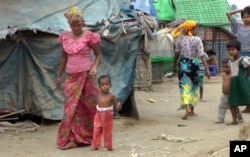When Pope Francis comes to Myanmar later this year for the first papal visit to this largely Buddhist country, he will be arriving in a land in need of healing.
Since independence in 1948, Myanmar has been beset by ethnic and civil strife, decades of military dictatorship and, since 2011, an uneasy transition to democracy that culminated in election victory for Nobel Laureate Aung San Suu Kyi in 2015.
Myanmar’s peace process has stalled as fighting continues between the military and armed ethnic groups in the north. In the west, tens of thousands of Rohingya Muslims have fled to Bangladesh as security forces battle a new Rohingya insurgency, which struck anew Aug. 25.
A challenge for the pope
So can Francis, who has made his voice known on, among other issues, the environment, immigration and the migrant crisis, help ease tensions in Myanmar? Or will his presence further inflame them?
“The motto of his visit is love and peace,” said Father Mariano Soe Naing, a spokesman for the pope’s trip who works with the Catholic Bishops Conference of Myanmar.
“So I think he would speak of love, the country here as a whole, they value love a lot, like metta [loving-kindness] in Burmese Buddhism also. Love is something very special for us. So his message, I think, he will try to emphasize this aspect of love, which will bring us to peace and harmony in the country,” he said.
Myanmar established diplomatic relations with the Vatican in May. The pope is expected to travel to Myanmar from Nov. 27 to 30. He will visit Yangon and Naypyitaw, and proceed to Bangladesh for a similar visit.
Rohingya crisis
Discussion around his visit has inevitably landed on the Rohingya crisis. The pope has mentioned their plight several times in sermons, most recently in the wake of new clashes.
Numbering around 1.1 million, the Rohingya are the largest stateless group in the world, and more than 120,000 live in IDP camps in Rakhine State following religiously motivated violence in 2012.
The crisis worsened last year when the Arakan Rohingya Salvation Army, a relatively unknown group, attacked police border posts, killing nine. The military launched “clearance operations” that rights groups have said could amount to crimes against humanity. The government has denied the claims.
Pope Francis’ vocal support for the Rohingya has created the impression that he is speaking for their rights alone, not the Rakhine Buddhists involved in the conflict.
Radical monk Wirathu was quoted in an interview as saying the trip was “political instigation,” but there has been little substantive pushback from religious leaders in general.
Christians are a small minority in Myanmar
One obstacle may be in the numbers. The pope’s upcoming visit to Colombia in a few weeks could have more sway because of its sizeable Catholic population, but Myanmar is almost 90 percent Buddhist and only 6 percent Christian, not all of them part of the Catholic Church.
And because the pontiff only makes the news in Myanmar when talking about the conflict, his image has been distorted, Father Mariano said.
“The reactions that we see in Facebook under the news of the arrival of the pope. Many would comment that they think the pope is the activist for the rights of those people, and some even do not even see that he is the head of the Catholic Church,” he said.
“Most of the time when they speak of the pope this issue is always in the media of Myanmar. So they really distort the image of the pope because the people in Myanmar know always the association is made with him and this case.”
Comments by the pope have not helped downplay the image.
The attacks have killed 11 police officers, one soldier and a civil servant, while a counteroffensive has caused the deaths of scores of Rohingya militants, according to state media. A number of ethnic minorities have also been killed. But on the Sunday following the violence, Francis spoke only about the persecution of the Rohingya.
“Maybe some people who brought the message to him did not give the complete message,” Father Mariano said. “That is the reason he prayed only for those people, but not those who were slain, not those who were brutally killed, the people who have to leave their house and run away, he did not mention those things.”
The Vatican declined to comment.
History of papal visits
But given the historic nature of the pope’s trip, and the way other popes have been able to influence positive change, there is still optimism.
“A visit by the pope is always very significant, politically and spiritually, and especially so when it is an historic first visit and to a country emerging from decades of dictatorship but still torn apart by conflict,” Benedict Rogers, author of three books on Myanmar and East Asia Team Leader at Christian Solidarity Worldwide, said in an email.
“One only has to think of John Paul II’s visit to Poland early on in his pontificate, which is credited with sparking the Solidarity movement that ultimately led to freedom across Eastern Europe.”








